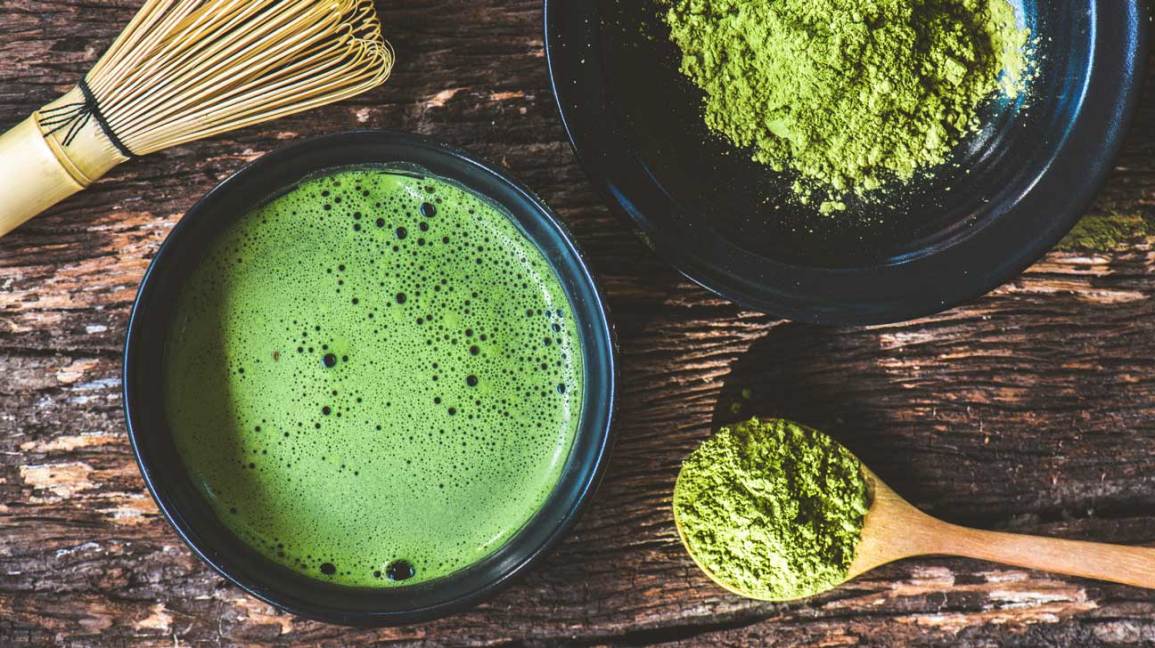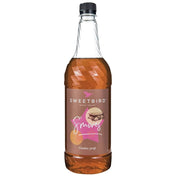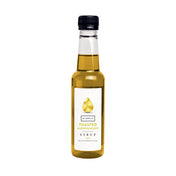What is Matcha Tea?
Matcha is a high-grade green tea leaf ground into powdered form. The green tea powder is whisked into hot water, instead of steeped, to form a frothy drink. The act of presenting, preparing, and sipping matcha tea is the backbone of the traditional Japanese tea ceremony.
Matcha’s origins are traditionally ceremonial, the green tea powder is widely popular around the globe in beverages like tea lattes or bubble tea, and as a culinary ingredient in dishes from ice cream to salad dressing.
Matcha Tea Origins
Before there were teapots to steep the tea leaves in, early Chinese custom was to grind the matcha tea leaves into a green powder then whisk the ground tea in a “matcha” bowl with hot water. While “whisked tea” was later abandoned by the Chinese population in favour of steeped tea leaves, the Japanese continued to use this method and went on to popularise the “Green Tea Whisking”.
One of Japan’s very own Zen priests who was studying in some of China’s Buddhist monasteries returned to Japan in the early 12th century with green tea plant seeds and bushes. The young priest, whose name was Eisai, used his experience gained in China growing and drinking “Whisked tea” to popularise what he called “the way of tea” as a meditation ritual within his community of Japanese Buddhist monks. Eventually, he spread the tea drinking custom throughout the rest of Japan.
This ceremonial tea drinking was loved with huge passion by Japan’s samurai class. The samurai were fearsome and strong warriors yet cultured and high-ranking members of Japanese caste society. The samurai identity was in fact built on Zen Buddhism, practicing principles like ritual, purification, and discipline.
It is thought that the samurai developed a complicated “Japanese tea ceremony” into an art form, enforcing it into a cultural tradition by adding detailed steps to the tea practice. These included hand movements, the design of the Japanese tearoom, a manual for how to sit properly and how to prepare and sip the tea. It is also thought that the Japanese tea ceremony was an integral part to samurai training, helping the samurai warriors sharpen their concentration, patience, focus, and ready their thoughts for battle.
The traditional Japanese tea ceremony, also known as “The Way of Tea” is a much loved practice in Japan and is focused around the art of preparing the green tea and presenting matcha in an almost meditative practise. Matcha Tea was developed as a sacred practice and the principals of the practice— “ Tranquillity, Purity, Respect & Harmony” are still central to tea ceremony today.
How Matcha is Different
Matcha Green Tea comes from the leaves of the Camellia sinensis plant. How the tea leaves are cultivated and processed is completely different than any other tea in the world.
All matcha Tea Leaves are made from shade-grown tea leaves, a labour-intensive process where the tea bushes are protected from the sun and light is filtered to the bushes in a very controlled manor. Shade over the plants boosts the chlorophyll production in the plant, giving the leaves a stunning rich green colour. The lack of sun on the leaves reduces the plant’s photosynthesis of the leaves, which in turn alters the naturally occurring levels of theanine, antioxidants, sugars, flavanols and caffeine. By controlling the sunlight over the tea leaves, the tea producers can dramatically alter the flavour and chemical make-up of the final tea leaves.
Seasonal: Only the new spring buds and first three leaves of the shade grown tea plants are hand-plucked for matcha production. Therefore, the window for production is very limited, which is one of the reasons matcha is one of the more expensive teas.
Steamed: Like most Japanese teas, the tea leaves destined for matcha are first steamed. The leaves are treated briefly with steam heat within hours of plucking to both halt the oxidation process and bring out the rich green colour of the shade-grown tea leaves even more. The steaming process creates a unique flavour profile that is often described as sweet and vegetal.
Stone ground: Instead of being rolled, shaped, and dried like traditional green tea leaves, the leaves destined for matcha are laid flat to dry and become tencha, the leaves from which matcha is made. The tencha leaves are then stripped of their stems and veins. The remaining leaf material is ground in slow-turning stone mills, yielding a smooth green tea powder.
Consumption vs. extraction: Traditional tea leaves are steeped in hot water to extract of the flavour and chemical properties from the tea leaves into a brewed tea that is sipped. Matcha green tea powder, however, is whisked into hot water and the ground tea leaf material, suspended in the water, is consumed with each sip.
Types of Matcha Tea
Matcha is grown in many regions across Japan, and each region and tea makers will produce slightly different flavour profiles and colours in the final ground green tea leaves.
There are two different types of Matcha Tea, which are sold in grades.
Ceremonial grade: Ceremonial grade Matcha is the highest quality matcha from lovingly cultivated tea buds and tea leaves. Ceremonial grade Matcha has the most attention to detail given during processing of the plant.
The outcome is to yield the a stunning delicate, smooth tasting matcha tea, with a fresh aftertaste. Ceremonial grade Matcha is meant to be enjoyed on its own, without sweeteners or additives, to really enjoy and appreciate the intended flavour.
Culinary grade: culinary grade matcha is much more robust and bitter in flavour, which makes it a great addition to culinary dishes and desserts.
Culinary Grade Matcha can include ground leaves that still have some stems and veins attached, making it a muddy green colour and less bright than ceremonial grade, and it may often include a mix of matcha powder from several sources. Culinary grade matcha should still be whisked with hot water into tea and sipped. Culinary Grade Matcha is a fantastic matcha tea to use with milk or plant-based milks for cappuccino & lattes and great for using in cocktails.
Caffeine Content in Matcha Tea
Matcha Green Tea typically has a lot more caffeine than normal mainstream green tea. It has a similar caffeine content to black tea and has less caffeine than the average brewed coffee. When we explained that the matcha green tea is shade grown earlier in the article, this is because it also allows the tea leaves to retain more of their caffeine content.
When you’re consuming ground matcha tea, when sipping matcha, you are consuming more of the caffeine content than that of tea made from green or black tea leaves. Like most drinks made from caffeinated plants (such as coffee beans) there is a specific level of caffeine per cup of matcha green tea that will depend on the how the matcha was processed and prepared.
Be sure and read the packaging carefully or ask your tea supplier directly for the caffeine information specific to the matcha you are buying.
|
220ml Beverage |
Avg. Caffeine Content |
|
Green Tea |
25 to 45 mg |
|
Black Tea |
12 to 66 mg |
|
Matcha |
30 to 75 mg |
|
Brewed Coffee |
90 to 250 mg |
Tasting Matcha
Matcha powder is whisked into hot water, therefore there is a special richness to matcha tea that differs from the traditionally brewed green tea leaf. Some unique profiles used to describe the flavour and mouth feel of matcha tea include: Umami, grassy, cooked roots vegetables, sweet, rich, creamy, full-bodied, and frothy.
Buying and Storing Matcha
Matcha Tea is best made and sipped as soon as possible after its production. Matcha is a ground tea, so if it is exposed to oxygen, it will immediately start to degrade the natural colour and flavour of tea. If stored sealed in a cool, dark place it can stay fresh for up to 12 to 16 weeks. To ensure you’re getting the best matcha worth sipping, buy it from a reputable company such as ourselves.
You can buy our matcha tea here
Preparing Matcha
Matcha is made differently from a typical brewed leaf tea and is very easy to make if you have the right tools. You can buy your Matcha Bowl & Bamboo Whisk Here:
Step 1: Bring 100 mg (about 1/3 cup) filtered or spring water to a boil. Remove from heat and let cool for 2 to 3 minutes.
Step 2: Place 1/2 teaspoon matcha powder in a small bowl. Add a splash of the hot water and mix with a bamboo whisk to form a smooth paste.
Step 3: Add remaining water to bowl and stir with the bamboo whisk, flicking the whisk back and forth, until matcha is incorporated and you get a thin frothy foam on top.
Step 4: Sip, savour, and enjoy.
Tips
- If you don’t have a bamboo whisk, use a spoon or small wire whisk—you just won’t get much of the frothy texture traditionally prepared matcha is known for.
- Don’t be tempted to pour boiling water over matcha; you will scorch the ground tea powder and it will become bitter and astringent.
- Use 1/4 cup water for a thicker matcha or 1/2 cup water for a thinner version.
- Replace water with your favourite milk (regular, coconut, almond, soy) for a latte.
- Pour the just prepared matcha over a glass full of ice for an iced tea version.




